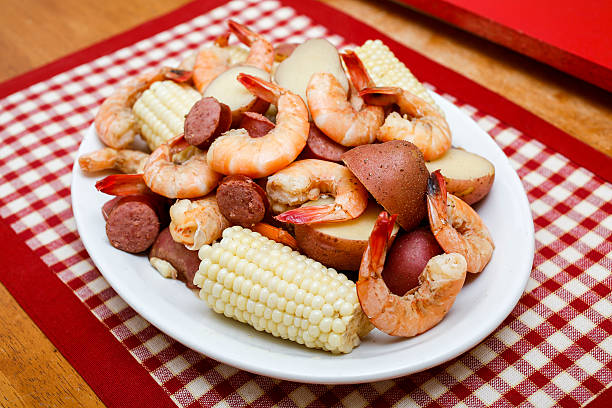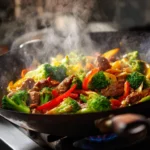Lowcountry Boil: A Coastal Culinary Tradition
Introduction
Lowcountry Boil, also known as Frogmore Stew, is a quintessential Southern dish that embodies the flavors and traditions of the coastal regions, particularly in South Carolina and Georgia. This one-pot wonder brings together an array of fresh seafood, sausage, and vegetables, all seasoned to perfection. In this exploration, we will delve into the origins of Lowcountry Boil, the key ingredients that make it a unique culinary experience, variations of the dish, and its cultural significance in the rich tapestry of Southern cuisine.
Origins and History
The roots of Lowcountry Boil can be traced back to the coastal communities of the Lowcountry, an area that encompasses the coastal plains of South Carolina and Georgia. The dish is said to have originated in the town of Frogmore on St. Helena Island, South Carolina, thus earning one of its alternative names, Frogmore Stew. It emerged as a communal meal, often prepared outdoors in large pots during social gatherings and community events.
The original Lowcountry Boil was a simple and practical dish, featuring ingredients that were readily available in the coastal region. Fishermen would combine the day’s catch with locally grown vegetables and traditional Southern spices to create a flavorful feast that celebrated the bounty of the sea and land.
Key Ingredients of Lowcountry Boil
1. Shrimp: The Crown Jewel of the Boil
Shrimp takes center stage in Lowcountry Boil, representing the seafood-rich waters of the Atlantic and the Gulf of Mexico. Fresh, succulent shrimp are added to the pot, and their sweet, briny flavor infuses the entire dish. The choice of shrimp can range from small to large, depending on personal preference and availability.
2. Crab: A Coastal Delicacy
Blue crab, a staple of Lowcountry cuisine, is often included in the boil. The tender, sweet meat of blue crab complements the shrimp, adding depth to the seafood melody. Some variations of Lowcountry Boil might include other crab varieties, such as Dungeness or snow crab, depending on the geographical location.
3. Sausage: A Savory Counterpoint
Sausage, typically a spicy andouille or smoked sausage, is a crucial component of the boil. Its smoky and savory notes mingle with the seafood, creating a delightful contrast. The sausage also contributes heartiness to the dish, making it a satisfying and well-balanced meal.
4. Corn on the Cob: Southern Sweetness
Fresh ears of corn on the cob are a staple in Lowcountry Boil, contributing a touch of sweetness and texture. The corn absorbs the flavorful broth, becoming a juicy and succulent addition to the medley. The corn’s natural sweetness balances the savory elements, enhancing the overall harmony of the dish.
5. Potatoes: Hearty and Satisfying
Potatoes, often small red or new potatoes, add a hearty element to the boil. They absorb the flavors of the broth and provide a satisfying starch to complement the seafood and vegetables. The inclusion of potatoes makes Lowcountry Boil a complete and fulfilling meal.
Preparation and Seasoning
The magic of Lowcountry Boil lies not only in its ingredients but also in the preparation and seasoning. The dish is typically cooked outdoors in a large pot, often over an open flame, giving it a communal and festive feel. The seasoning blend is a key element, usually featuring a combination of Old Bay seasoning, Cajun spices, garlic, and onions. The aromatic spices infuse the broth, creating a tantalizing aroma that wafts through the air, signaling the arrival of a Southern feast.
Variations of Lowcountry Boil
1. Beaufort Stew
Named after the town of Beaufort in South Carolina, this variation of Lowcountry Boil often includes a wider variety of seafood, such as clams and mussels. The addition of these shellfish introduces an extra layer of brininess and complexity to the dish.
2. Cajun-Style Boil
Influenced by the bold flavors of Cajun cuisine, the Cajun-style Lowcountry Boil incorporates a spicier seasoning blend, featuring ingredients like cayenne pepper, paprika, and additional herbs. This variation appeals to those who enjoy a bit of heat in their seafood boil.
3. Island-Style Boil
In coastal areas with a tropical influence, such as the Sea Islands, a variation known as Island-Style Boil may include exotic additions like plantains or tropical fruits. The result is a fusion of Caribbean and Southern flavors, offering a unique twist on the classic Lowcountry Boil.
Cultural Significance
Lowcountry Boil is more than just a meal; it’s a communal experience deeply rooted in Southern culture. Historically, it served as a practical and convivial way for communities to come together, sharing the bounty of the sea and land. Today, it remains a symbol of hospitality and celebration, often featured at family reunions, beach gatherings, and festivals.
The outdoor preparation of Lowcountry Boil adds to its cultural significance. The act of cooking and sharing the meal outdoors fosters a sense of community and togetherness, reinforcing the Southern tradition of hospitality and camaraderie.
Conclusion
Lowcountry Boil stands as a testament to the vibrant and diverse culinary landscape of the Southern United States. From its humble beginnings as a communal seafood feast in the Lowcountry to its status as a beloved dish enjoyed nationwide, this coastal culinary tradition continues to evolve while remaining deeply connected to its roots. As you savor each bite of shrimp, crab, sausage, and vegetables, you’re not just indulging in a delicious meal—you’re partaking in a cultural experience that celebrates the richness of Southern heritage. Whether enjoyed on a balmy evening by the sea or at a festive gathering with friends and family, Lowcountry Boil invites us to savor the flavors of the coast and embrace the warmth of Southern hospitality.












